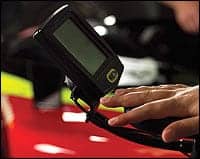 |
Building a better wheelchair accessory, let alone a better wheelchair, is part creative engineering, part listening, and part seeing the same-old, same-old in a new way.
There are wheelchairs that do not need much, if anything, in the way of accessories. Think of an airport wheelchair that helps an elderly person travel from the ticket counter to the gate. But for wheelchairs that assist people with chronic and temporary disabilities, the right accessory can make all the difference to the disabled person trying to function in a world that the able-bodied may take for granted.
From a simple cup holder to a shock absorber for smoother rides over sidewalk curbs to stump supports, accessories have come a long way since the standard footrest, and even a footrest can be specialized. There are swing-away footrests, elevating footrests, elevating/articulating footrests, and angle-adjustable footrests.
Don Wanat, president of a Mill Creek, Wash-based company that manufactures seating and positioning products for wheelchairs, says that his company designs its products so that individuals can use its accessories to maximize functionality. Through physical therapists, clients, and physicians, the company tries to understand the needs of people with conditions such as cerebral palsy and its many types; severe, traumatic brain injuries; spinal cord injuries; and muscular dystrophy, multiple sclerosis (MS), and other degenerating or incapacitating illnesses.
“Once you get beyond the chair, clearly it’s the accessories that come into play,” says Wanat. “The knowledgeable, well-trained therapist, dealer, and provider are interested in optimizing the patient’s ability to fully function as normally as possible, and to try to correct the conditions of the situations that they’re confronted with. Where correction is not a reasonable goal, then they want to accommodate the condition as best as possible. I think that’s where each accessory product comes into play; from the footrest to the seat back cushion, and all the way to headrest. And therein lies the interesting part of our business, where each client is an individual unto themselves, with their own specific and special needs.”
Even people with the same condition can need different accessories. Two individuals with MS may require different accessories to function, depending on their size, weight, and the severity of their current condition.
FINDING THE RIGHT FIT
For example, relieving pelvic pressure with the right seating accessory can bring great relief to a person sitting in a wheelchair. One of the latest accessories that Wanat’s company has developed is a pelvic positioner, which provides lateral hip support to maintain proper pelvic positioning. In addition, it can simultaneously work as a padded hip belt. Wanat says that the Arcufit was designed to make it easier to get in and out of a wheelchair. “It’s kind of a mix between a subasis bar, a hip guide, and a pelvic positioning belt, offering some of the benefits of each of those.” The product is typically covered by Medicare and insurance companies.
It is the “improved and different” wheelchair accessories that are most prevalent in the industry. For Jason Pietromica, associate product manager for a Ridgeville, Ohio-based company that produces wheelchair parts and accessories (as well as scooters and power chairs), the most interesting products are those that build a better mousetrap—a better version of an accessory that already exists. That can include minimal, yet significant improvements to common products.
 |
| Well-designed handrims enable the user to more safely and efficiently navigate a wheelchair. |
For example, the Pietromica’s company has been working with a Boulder, Colo-based media storage group on a line of arm pouches, backpacks, and other wheelchair storage accessories. Pietromica says that the new backpacks and pouches are available in colors (making them look less drab and institutional), and were designed with input from clinicians and their patients. Says Pietromica, “A lot of people who are using these things don’t have the dexterity to grab a small zipper. So these packs [were made] with oversized zipper loops that are easy to grab.” For example, the company created a pouch for under a wheelchair seat made with rubberized material on the outside with drainage holes, protecting the contents when the wheelchair is rolling through puddles. While the products are specifically for wheelchairs, generally, Medicare and insurance companies do not cover them.
Innovative enhancements to standard wheelchairs are also on the market. The Pietromica’s company recently added fitted handrims to its product line. Standard wheels in the industry are usually made out of aluminum, steel, or chrome tubing that is fairly thin, especially for hands that have diminished strength or dexterity. The lack of ergonomics and the repetitive movements can cause or exacerbate carpal tunnel syndrome or shoulder injuries. Clients often compensate for awkwardly designed handrims by propelling themselves through the tires, making their hands dirty, sometimes callused. Individuals also may injure their fingers by accidentally letting fingers drop into the spokes. The fitted handrims addressed these problems with larger, ovular tubing, and by providing a larger gripping surface with several optional textures. Additionally, the rims have a groove that is specially contoured to fit the thumb for a better grasp. The wheel’s spokes are also shielded, protecting the fingers from becoming caught. According to Pietromica, the company has performed studies showing reduced shoulder and wrist pain with use of their product compared to using standard rims. Of course, if the client feels more comfortable using the handrims rather than gripping the tires, they will have fewer calluses and cleaner hands. These handrims are available for most wheelchair brands and wheel sizes, and should be covered by Medicare and most insurance with proper documentation.
In addition to being designed for the disabled person, some new accessories are developed for health care providers in mind; for example, hospitals that have acquired several different brands of wheelchairs. As a result, the hospital stocks replacement parts for each brand. Consequently, some manufacturers have designed universal wheelchair accessories. In fact, Pietromica’s company has developed a universal anti-tipping device, which can attach to most standard wheelchairs. While this accessory remains effective as a wheelchair anti-tipping device, it also benefits health providers attempting to reduce their inventory and costs for replacement parts.
SIMPLE MECHANICS
Wheelchair accessories may be as mechanically simple as an anti-tipper, but there are some new sophisticated, electronic accessories that help bring independent mobility and utility to the most physically challenged. Ross Charest, North American product manager for a Longmont, Colo-based company known for its power wheelchairs and durable medical products, says that his company tries to develop its accessory technology at a high level, while making it available to a broad population.
 |
| Easily accessed storage bags and packs are designed with input from clinicians and wheelchair users. |
One of the company’s latest high-tech accessories is an environmental control device offered as an option on several power chairs. An environmental control device is similar to a television universal remote control. Instead of pushing buttons, it enables the user to see simple computer icons on the display screen. The user then operates the power chair by interacting with a joystick, sip and puff, or head array. Besides driving the chair, the device can also be programmed to operate other common household electronics, such as televisions and DVD players, as well as home assist products that can remotely turn on light switches, answer telephones, or open and close curtains. The product is engineered so that it is compatible with any home assistance device that uses either infrared or x10 technology. Moreover, the display’s menu and icons can be customized, enabling an individual to program their chair to their unique strengths and preferences. Similar products are available, but they typically cost thousands of dollars, whereas Charest’s company has consciously attempted to make this accessory relatively affordable, around $500.
Another advanced accessory that the company has just introduced is a powered elevation seat that can raise the wheelchair user 11 inches above the chair’s normal seating height. The extra height can be a significant help for individuals who have a level of independence in their lives, but could benefit from having a longer reach in a variety of situations.
As for the future of wheelchair accessories, some of the development may depend on the industry as a whole. Over the last several years, there have been several mergers in the durable medical products field. Wanat believes that as the smoke settles from the consolidation, there will be a reemphasis on bringing accessories into another cycle of improvements. The next generation of accessories will most likely include more titanium and composite plastics products that result in lighter weight with strength and durability.
Charest says that modern chairs are higher functioning and more reliable than the wheelchairs made 10 years ago, but that manufacturers still need to bridge the gap between medical requirements and lifestyle requirements. “Our hope is that we’ll see more consumer-style technology find its way into the power wheelchair market. Cell phones have been around for quite a while, but we haven’t been able to get integrated cell phone capability into a power wheelchair. I think that’s where the future of chairs is going.”
Tor Valenza is staff writer for Rehab Management.





